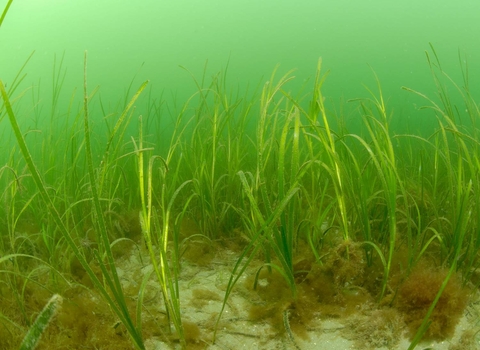What is seagrass?
These undersea meadows are home to some amazing wildlife and store huge amounts of carbon making them a key natural solution to the climate crisis.
Seagrasses get their name from their green, grass-like leaves, which form extensive lush meadows (or beds) underwater, just like the grass we see in our fields. One of the reasons seagrasses are so special, is that they are one of only three marine flowering plants in the world. Seagrasses live, pollinate and reproduce in seawater, but are restricted to shallow coastal areas where there is enough sunlight for them to grow and thrive. Amazingly, seagrasses are estimated to have first evolved when dinosaurs still walked the earth, over 100 million years ago. Today, there are over 60 species of seagrass worldwide, five of which can be found here in the UK.
Seagrasses are easily confused with seaweeds; whilst they are both plant-like and live on our shores, there are some key differences. Seaweeds cling onto the seafloor, often rocks or reef, with a ‘holdfast’ and transport nutrients directly from the water through their body. Whereas, because they are flowering vascular plants, seagrasses have an internal transport system for nutrients they take in through a root system based in seafloor sediment.
Why are seagrass habitats important?
Seagrasses are sometimes known as ecosystem engineers because they can profoundly change the environment in which they are found, creating unique habitats which become biodiversity hotspots for a wide range of wonderful marine wildlife. The long leaves of seagrass are home to all kinds of anemones, hydroids, sea-squirts, sea mats and different coralline algae. However, seagrasses also stabilise and oxygenate the sediment, slowing down water flow, which makes an ideal habitat for juvenile and adult crabs, sea snails, cuttlefish, pipefish, and even seahorses. The UK has two native species of seahorse; short-snouted and long-snouted (spiny) seahorse, and both are often found around seagrass beds.
Just like the plants and trees in our countryside and woodlands, seagrasses are primary producers, meaning they use the sun to make food so that they can grow. Not only does this mean they are important part of food webs as a source of food for other marine and coastal animals including sea urchins, crabs and geese, but they also filter pollutants and reduce coastal erosion by reducing the force of waves hitting our coasts.
However, as the climate emergency grows with increasing levels of carbon dioxide in our atmosphere, seagrasses also have a hugely important role in tackling climate change.
A natural solution to the climate crisis
Seagrass plants and meadows have the potential to sequester and store huge amounts of carbon dissolved in our seas – this is known as ‘blue carbon’. Similarly to trees taking carbon from the air to build their trunks, seagrasses take carbon from the water to build their leaves and roots (known as photosynthesis). As seagrass plants die and are replaced by new shoots and leaves, the dead material collects on the seafloor along with organic matter (carbon) from other dead organisms. This material builds up forming layers of seagrass sediment, which if left undisturbed, can store carbon in the seafloor for thousands of years.
Considering that seagrass captures carbon at a rate 35 times faster than tropical rainforests, and account for 10% of the ocean’s total burial of carbon (despite covering less than 0.2% of the ocean floor), they are one of our most important natural solution to the climate change crisis.
Threats and pressures
Despite how vitally important seagrasses are for wider ecosystem functioning, unfortunately, our prized seagrass habitats are in danger. Globally, it's estimated that we lose an area of seagrass the size of two football pitches every hour, while in the UK it is estimated that we have lost 92% of our seagrass beds in the last century.
In the 1930s a significant proportion of seagrass in the UK died from a wasting disease, which attacks the leaves and prevents photosynthesis, ultimately killing the plant. Physical disturbance of seagrass plants can also dramatically reduce seagrass survival. This can come in the form of natural events such as strong waves and storms, but more commonly from man-made disturbances which seagrasses are less well-equipped to recover from such as coastal development, dredging, anchoring and boating activities to name a few. Pollution and nutrient run-off from land is also a key threat to seagrass meadow health and productivity. Increased nutrient loads cause algal blooms, which often block sunlight necessary for seagrass growth.
Conservation and recovery
If we act now, we can bring our seagrasses back. Despite vast losses of this precious habitat around the UK and globally, there is cause for hope. When damaging activities are removed and seagrasses are given the opportunity to thrive, it can be surprisingly resilient. Not only can they recover from recent disturbances, but seagrass meadows can spread and re-colonise areas of our coast in which they haven’t been recorded in decades.
Research into how conservationists can protect and recover seagrass habitats has begun to yield positive results. Whilst habitat management is not easy in the sea it is possible! Seagrass restoration projects are being piloted in the UK, with the help of The Wildlife Trusts. Seeds are being collected from various sites and cultivated, ready for replanting to create new meadows. Other work includes looking at mooring systems that reduce the physical impact of boating and educating people around the importance of seagrass. Fortunately, seagrass habitats feature in a number of our Marine Protected Areas, but designation is just the first step – to ensure their long-term future, appropriate management and monitoring of these sites is essential.
Whilst these meadows may remain unseen by many, they have a crucial role in bringing about nature’s recovery in the sea.





